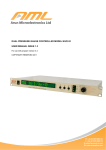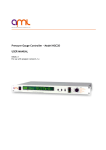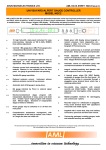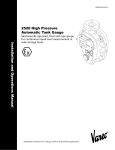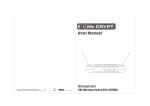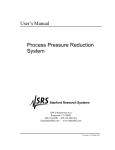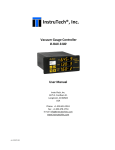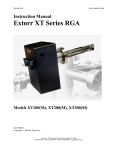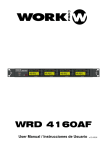Download NGC2 – Ion Gauge Controller - Arun Microelectronics Limited
Transcript
ARUN MICROELECTRONICS LIMITED PRESSURE GAUGE CONTROLLER MODEL NGC2 USER MANUAL ISSUE 2.2 For use with program version 3.1 COPYRIGHT RESERVED 2009 AML Part Number SNGC2QG INDEX Description Page 1. Warnings & safety 2 2. Installation 2.2 Ion Gauge 2.3 Instrument 2 2 3 3. Description 4 4. Preparation for Use (Setup) 4.1 Switching On 4.2 Setup 4.3 Passwords / Units 4.4 Interlock / Autostart 4.5 Gauges 4.6 Relays 4.7 Bake 4.8 Degas 4.9 TSP 4 4 5 5 6 6 6 6 6 7 5. Preparing for Operation 5.1 Function switch in Operation 5.2 Relay Trip Levels 7 7 7 6. Display Mode 6.1 Ion Gauge 6.2 Capacitance Manometer 6.3 Leak Detector 6.4 Sensitivity 6.5 Temperature 6.6 Emission Current 8 8 8 8 9 9 9 7. Operation of Ion Gauge 7.1 Starting 7.2 Changing Emission Current 9 9 9 8. Degassing 10 9. Baking 11 10 Faults 12 11 Remote Operation 12 12 Recorder Output 13 13 Forgotten Password 13 14 Assistance 13 APPENDIX A Gauge Principals 14 APPENDIX B Interface Manual 15 © Arun Microelectronics Ltd 2008 1 The information contained in this manual has been carefully checked and is believed to be correct. AML accepts no responsibility for any errors. 1. WARNINGS and SAFETY Instruments are shipped with password protection disabled. If you set a password you must record what it is. Password usage restricts access to most functions of the instrument, other than pressure measurement. The conditions set at manufacture assume that you do not require any interlocks and that the ion gauge has a Tungsten filament. You may fuse coated Ion Gauge filaments if you do not set up the instrument appropriately. Allow several minutes for Pirani gauges to reach operating temperature after switching on before using them for interlock, autostart or process control. High voltages are present within the instrument when operating and for some seconds after switching off. Remove the mains lead before removing the cover for any reason. Two fans are used sequentially for cooling. Orange Status LEDs on the front panel indicate which fan is being used. If a fan fails a message is displayed at the time of failure and the LED for that fan flashes thereafter. Replace a failed fan as soon as possible. If the remaining fan fails operation of the ion gauge will be disabled. A spare fan and fitting instructions are packed with each instrument. Always keep at least one spare fan, which must conform to the specification printed on the rear panel. Fans are available from AML distributors. Do not return instruments to AML distributors for fan replacement: this is not covered by the warranty. Discharges from X-ray power supplies and other high-voltage and high-energy sources (which are commonly used in vacuum systems) into the Ion Gauge may damage the instrument. Such damage is not covered by the warranty. Discharge damage will be minimised by decreasing the impedance of the strap/cable from the earth stud on the instrument to the vacuum chamber ground. This connection may also be essential for operator safety: follow the safety instructions and recommendations of the supplier of any high-voltage equipment used in the vacuum system. 2. INSTALLATION 2.1 Checks on receipt of the instrument. On receipt of the instrument remove all packing material and check that all items on the shipping list have been received. Report any damage or shortages to the Company or the Distributor who supplied the instrument. The packing material has been specially designed to protect the instrument and should be retained for possible future use. 2.2 Ion gaugehead installation. Consult the information supplied with the gaugehead for advice on flanges, gaskets and adaptors for mechanical fixing. Mount the gaugehead in a position where the free electrons generated in its vicinity will not affect other equipment. The performance of the ion gauge may be affected by other electron or ion generating processes within the vacuum chamber: should shielding of the gaugehead be necessary, ensure that the conductance between the gaugehead and volume of interest is not significantly decreased by its presence. The orientation of the gaugehead should be such that the filament is to the side of, or below, the grid structure. This will ensure that if the filament should sag or break it will not short-circuit to the grid. The gauge and controller are protected from all normal failure modes of either. Users should be aware of potential hazards from other equipment, however, particularly those introducing high voltages into the vacuum chamber © Arun Microelectronics Ltd 2008 2 2.3 Instrument installation. Mounting. The instrument is suitable for mounting in a standard 19" rack and occupies 1U ( 1.75" , 44.5mm) of the rack. The mounting holes in the front panel are intended for retaining the instrument in the rack and will not support its weight. Additional support is required toward the rear and various arrangements are provided by rack manufacturers for this purpose. Ventilation. The instrument is forced-air ventilated through grilles on the sides and a vent in the rear panel. Mount it in a location where there is an adequate supply of air as close as possible to cool room-ambient temperature. The instrument is tolerant of, and is compensated for, operation at elevated ambient temperatures up to 45° Celsius. Long-term accuracy and reliability will be enhanced by operation at the lowest possible temperature. If there are other instruments in the rack which generate significant amounts of waste heat, try to ensure that this is deflected away from this instrument. Connections. NGC2 UHV PRESSURE GAUGE CONTROLLER T/C JUNCTION MUST BE ELECTRICALLY INSULATED LINK TO INHIBIT EMISSION R EC CM ION GAUGE COLLECTOR ILOC K K T/C (BAKE TEMP) ARUNDEL WEST SUSSEX AUX 0V ARUN MICROELECTRONICS LTD ENGLAND REMOTE (RS232C) SER. No. PIRANI 1 PIRANI 2 5A MAXIMUM RESISTIVE LOAD FIT COVER FOR VOLTAGES > 24V 240V AC MAXIMUM SNUB INDUCTIVE LOADS RELAY TERMINAL BLOCK IS PLUG-IN CONTACTS SHOWN IN DE-ENERGISED STATE RLA REC= + 1V / DECADE 0V=1E-13A Rs=1KOHM AUX TERMINAL BLOCK IS PLUG-IN USE ONLY AML TYPE PVU PVB OR AIG17P GAUGES RLB RLC 40MM 12V MID-SPEED NPN OPEN-COLLECTOR TRANSISTOR TACHO FAN1 FAN2 ION GAUGE RLD FOR STABLE EMISSION, AND TO COMPLY WITH E.U. LV AND EMC DIRECTIVES USE AML- APPROVED GAUGES AND LEADS The instrument earth stud must be connected directly to the chamber ground with a lowimpedance strap/cable: there must be no ferrite components installed on it. Use AML-approved gauges with properly-screened leads. The ground braid of the ion gauge cable must be connected to the instrument ground stud. Third-party ion gauge cables may not allow compliance with EU EMC Directives and may lead to unstable emission. As a minimum they must comply with the following. There must be an overall screen on the lead and an inner screen on the collector connected to the BNC shell. These screens must not connect either to the vacuum chamber or to each other. Ion gauge leads should not be installed close to cables carrying high alternating currents or through areas where there are significant alternating magnetic fields. They should be constrained, since movement or vibration will generate charges or currents and these may disturb UHV pressure readings. AML Pirani gauges PVU2, PVB2 and are suitable for use with this instrument. Pirani 1 pressure is used for Ion Gauge Interlock and Autostart functions and should be installed in the same chamber as the Ion Gauge. Pirani 2 is normally used for backing-line pressure measurement. The Auxiliary (AUX) and Relay connector terminal blocks are plug-in. The CM output is connected to CM and 0V on the AUX Connector. The recorder is connected between REC and 0V. If the Bake function is to be used then relay D must be assigned to Bake. It is used to switch on the Bake heaters when energised. Do not connect heaters directly to relay D: use a contactor and fit a snubber directly across its coil. The K thermocouple tip must be isolated from the vacuum chamber and situated where it accurately represents the bake temperature. Mineral-insulated thermocouples with a miniature flat-pin thermocouple connector should be used. If the TSP function is to be used then relay C must be assigned to TSP. Relay C is energised for 0.5 seconds to fire the TSP. Consult the TSP manual for further information. © Arun Microelectronics Ltd 2008 3 3 DESCRIPTION 3.1 Front panel. -1 1 0 +1 +5 Pa -10 -9 -8 -7 -6 -5 -4 -3 -2 -1 PASSWORD / UNITS 0 RLA 1 PIRANI 2 INC DEC RLB RLC -3 -2 0 -1 +3 mB Torr -12 -11 -10 -9 -8 -7 -6 -5 -4 -3 REMOTE -2 CHANGE DISPLAY NGC2 UHV PRESSURE GAUGE CONTROLLER FAN 1 FAN 2 FIL 1 FIL 2 RLD www.arunmicro.com ENT/ TRIPS BAKE PROG. MAN. QUICK OFF DEGAS OFF 5mA EMISSION 0.5mA INTERLOCK / AUTOSTART GAUGES RELAY ASSIGNMENT SETUP BAKE DEGAS TSP INC, DEC and ENT are pushbutton switches with tactile feedback. They select the format of pressure display, modify setups and change parameters before and during Ion Gauge operation. Only press one switch at a time. The rotary Function Switch has two sets of positions: for setup and operating. The SETUP locations are labelled in orange print. The switch must be stationary for a brief time before any action results. There is a mechanical stop between the Emission and TSP positions. A set of status LEDs is situated in the Status Window adjacent to the function switch. The LEDs on the right side of the window show further information about operations involving the Ion Gauge, such as the Degas program in use. The LEDs on the left side indicate the status of the instrument, the fans and the number of the filament in use. Flashing of the display or of individual LEDs either require a response by the user or indicate potentially hazardous operations. The messages and displays shown in the large Display Window are largely self-explanatory and may be accompanied by sounds. The units of the pressure display are indicated by one of three LEDs toward the left of the display area. The centre orange LED indicates that mBar has been selected, the green LED above it indicates Pascal and the green LED below indicates Torr. The legends above and below the display window indicate the units and the exponent scale for interpreting the bargraph displays of Ion Gauge pressure. At the right hand end of the display area are four green LEDs indicating the status of the four relays available for pressure-related control, Bake and TSP control. Each LED illuminates when the associated relay is energised. 4 PREPARATION FOR USE (SETUP) New users should explore and familiarise themselves with the use of the controls and displays before connecting any gauges or wiring to the rear panel. 4.1 Switching on. Turn the Function Switch to one of the OFF positions. Connect and switch on the mains supply and wait for the self-diagnosis and ‘signing on’ messages to run (approx. 30 seconds). A sequence of displays allows verification that all the display LEDs are working. Both fans are checked for correct operation. The ambient temperature of the incoming air near the electrometer is displayed. The display will finally show Pirani 1 pressure. Pirani gauges take some time to stabilise before they indicate correct pressure. If Pirani 1 is not connected the display will show ‘Pir 1 Atm.’. If the Function Switch is at a position calling for emission at switch-on emission is inhibited and 'Switch Em Off' is displayed. © Arun Microelectronics Ltd 2008 4 4.2 Setup, General description. Setups are distributed among seven switch locations in order to reduce the time taken to modify a few parameters. There is no restriction on when, how many times or in what order you can enter a particular setup. The sequence of setups in 4.3 to 4.9 below is logical and recommended for familiarisation and initial use. It involves moving the position of the Function Switch sequentially in a clockwise direction. You can view all of the settings in any setup without modifying them by pressing ENT at each stage until ‘Setup Finished’, is displayed. You can move the Function Switch off its present SETUP position at any time and back again to repeat the setup as many times as you wish. Some setups require specific conditions to be set in other setups and you will be prompted to resolve contention. Modifying settings, definitions or assignments in some setups will modify others automatically if there is inconsistency. If you do not require the Bake or TSP functions they can be disabled by not assigning relays to them. If the instrument is waiting for a response from you then part of the display will flash, indicating that a choice or a numeric entry is required. INC and DEC modify the choice or number and ENT confirms it. If you do not modify the displayed setting for a few seconds the instrument will make a periodic beep. If you do not respond for a further few seconds then the current display will be replaced by ‘Setup Aborted’ or another display and the setting or choice at the aborted stage will revert to its former setting. INC and DEC may be pressed briefly to change a number by a single step. Maintaining the switch pressed causes the number to change repeatedly at an increasing rate. Releasing the switch reduces the rate of change to the minimum on a subsequent press. If you move the Function Switch after modifying a choice or value but have not confirmed it with ENT then the existing choice or value is unchanged. You may move the Function switch part-way though a sequence if you do not wish to modify subsequent settings within a setup. E.g. in SETUP GAUGES you may change the filament in use without progressing through filament material, overpressure, and Capacitance Manometer. Setup parameters are stored permanently by the instrument. Setups and access to operating parameters and functions can be password-protected to prevent unauthorised use. 4.3 Setup – Password / Units Turn the Function Switch to PASSWORD/UNITS. If the initial display is ‘Password ????’ then a password has already been set. If the initial display is ‘Password ? No’ and you don’t want to use a password press ENT and continue with selecting units of pressure. If you do want to use a password then press INC to change ‘Password ? No’ to ‘Password ? Yes’ and press ENT. Change the password number with INC or DEC and confirm it with ENT. Do not set the password to the default number, 7FFF, as this is not secure. If a password has been set the initial display is ‘Password ????’. You will have to set the correct number in the display using INC and DEC and confirm it with ENT. You can then disable password usage or change the password. If another user has inadvertently set a password refer to section 13 'Password forgotten?'. Select the units of pressure display. The units may be Torr, Pa or mB and the current selection will flash in the main display. Press INC or DEC to change to the desired units and confirm your choice by pressing ENT. 'Setup Finished' will be displayed. If the units are already as desired either press ENT or turn the Function Switch. © Arun Microelectronics Ltd 2008 5 4.4 Setup - Interlock / Autostart Turn the function switch to INTERLOCK/AUTOSTART. Interlock prevents the ion gauge operating when Pirani 1 pressure is above a set pressure. Autostart starts the ion gauge the first time Pirani 1 pressure falls below the set pressure. The set pressure is the same for both functions. If they are used together Interlock is suspended until the Ion Gauge has started. Do not confuse the Pirani Interlock with the External Interlock on the Auxiliary Connector. 4.5 Setup - Gauges Turn the function switch to GAUGES. Select the filament in use. Change of the filament in use is allowed without entering the password if set. Define the material type for each filament. This automatically sets the current limit for the filament. Use the Yttria setting for thoria-coated filaments. Two different filament materials may be set, but such use is not recommended. Define the ion gauge overpressure trip to suit the filament material and your customary practice. The overpressure trip (OVP) will automatically set the maximum trip pressure of any relay assigned to that gauge to half the OVP. A maximum OVP of 1e-3 mB/Torr is recommended for an AIG17G with Tungsten filaments or 1e-2 mB/Torr with coated filaments. Define whether you have a Capacitance Manometer (CM) on the vacuum chamber. The full-scale pressure and units of the CM are as defined by the manufacturer for +10v output. The units of display are chosen independently under PASSWORD/UNITS. (The CM output is connected to CM and 0V on the AUX Connector.) Define whether you require the instrument to recommend when emission current should be changed. (Em Promp?) INC or DEC will cycle between yes or no. Press ENT to accept a change. Refer to section 7.2 for Ion gauge emission details. 4.6 Setup – Relay Assignments Turn the Function Switch to RELAY ASSIGNMENT. You may assign any relay to any gauge or to ‘None’. Trip levels for relays are set to maximum on assignment and can be modified at positions EM and OFF on the Function Switch. Refer to section 5.2 for instruction on trip setting, Relays assigned to ‘None’ are deenergised. You cannot assign a relay to ‘Cap. Man’ if no CM has been defined. If a relay is assigned to CM and the definition of the CM is subsequently cancelled the relay is automatically re-assigned to ‘None’. You may assign only Relay C to trigger the TSP. You may assign only Relay D to Bake. 4.7 Setup - Bake Turn the Function Switch to SETUP BAKE. Change the temperature and pressure setpoints and set the total bake time, as required. During Bake relay D is energised when both the temperature and pressure are below their setpoints. The hysteresis on temperature is 5C° and on pressure is 50%. Refer to section 9 for more information. 4.8 Setup - Degas Turn the Function Switch to SETUP DEGAS. The settings for degas parameters should not be changed until manual degas has been run (see section 8) and settings appropriate for your chamber and usage have been derived. © Arun Microelectronics Ltd 2008 6 4.9 Setup - TSP (Titanium Sublimation Pump). Turn the Function Switch to TSP. Timing of TSP firings is according to a fixed table of current pressure against the elapsed time since the last firing. Relay C is energised for 0.5 seconds to fire the TSP. ‘Countdown’ gives display and audible warnings of an impending firing at increasing frequency as the firing time approaches. ‘Man Inhibit’ gives the user the opportunity to abort the firing during the countdown. The first firing will occur 10 minutes after the pressure indication falls below 1e-6mBar. The TSP will fire 10 minutes after starting emission if the pressure is below 1e-6mBar, and thereafter according to the table. The first warning occurs 8 minutes before firing. 5 PREPARING FOR OPERATION Read the sections on SETUP and INSTALLATION first. 5.1 Use of the Function Switch in the operating positions. The Function Switch must be stationary for a brief time before any action results. This allows you to rotate the switch through various operating positions without starting the ion gauge or other functions. The ion gauge will be started about one second after rotating it to the EM position. As additional security, Bake or Degas will not start unless you enter the password (if set) and then select and/or confirm your requirement. 5.2 Relay trip levels and Pirani ON/OFF switching. Relay trip levels can be reviewed and modified in the OFF and EM position of the Function Switch by pressing ENT when a pressure reading is being displayed. If a password has been set you must enter it to be able to modify settings. If the password is set and you do not enter it you may view the settings but cannot change them. The relay trip levels or their assignments to Bake/TSP are displayed in sequence, starting with Relay A and progressing to Relay D. The next in the sequence is shown each time that you press ENT. The status LED for the relay and the numeric setting of the trip level flash if trip modification is allowed. Modify the displayed setting by pressing INC or DEC, then press ENT to confirm it and display the next. RLA RLD If the Function Switch is in the OFF position then review of Relay D trip level is followed by the ON/OFF status of the Pirani Gauges. Pirani Gauges can be switched on or off with INC or DEC followed by ENT. Switching Pirani Gauges off suspends the operation of the Pirani Autostart and Interlock functions. It is not possible to switch the Piranis on or off while the Ion Gauge is in emission. If you make no response at some stage of the sequence the display ‘times-out’ to the pressure display that was current before the start of the sequence and the setting at the interrupted stage is unchanged. Relays assigned to a gauge are energised when the pressure falls below the trip level and de-energised at twice the trip level. If a trip level is set at the upper limit of its range the relay is permanently de-energised. If a trip level is set at the lower limit of its range the relay is permanently energised. Setting trip levels at these limits does not cancel the assignment of the relay. Relays assigned to ’None’ are de-energised. The maximum setting for any relay assigned to the Ion Gauge is half the overpressure trip setting. Changing the overpressure trip may cause the status of relays assigned to the Ion Gauge to change if the current pressure is between the former and new overpressure, after emission is re-started. Numeric values of trip levels will change automatically if the units of measurement are changed, in order to maintain the trip levels at the same pressures. © Arun Microelectronics Ltd 2008 7 6 DISPLAY MODE In the OFF and EMISSION positions the format or content of the display can be changed by pressing INC or DEC. The selected display mode persists until you change it or turn the Function Switch. The pressure display for the Ion Gauge or Pirani Gauges is only available if the gauge is operating. In Bake and Degas the display formats are fixed. Ion gauge sensitivity and leak detection are treated as display modes. The Pirani gauge low-resolution bargraphs are displayed whenever the Pirani gauges are operating. The Relay Status LEDs are displayed at all times. The default display with the Function Switch at OFF is Pirani 1 numeric pressure and at EMISSION is numeric Ion Gauge pressure. Moving the Function switch restores the default display. RLA RLB RLC -3 -2 -1 +3 RLD mB Torr Pirani 1 pressure 3x10-2 mBar. Bargraph at upper left shows same pressure. Ion Gauge pressure 2.4x10-10 units , pressure decreasing, RLA and RLB energised 6.1 Ion Gauge Ion gauge pressure can be displayed in numeric, single-decade, auto-ranging bar-graph or full-range bar-graph formats in EMISSION. Pirani 2 Pressure in numeric format may also be displayed. Bar-graph displays are most useful during pump-down and for monitoring backing line pressures. mB Torr Single decade Ion Gauge pressure 6.2x10 -10 units, pressure increasing -10 -9 -8 -12 -11 -10 -7 -9 -6 -5 -8 -7 -4 -6 -3 -5 -2 -1 -4 -3 0 -2 -8 Full-range Ion Gauge Pressure 2x10 Torr, pressure decreasing 6.2 Capacitance Manometer Capacitance Manometer pressure is only available in numeric format and only if the gauge has been setup. 6.3 Leak Detector The leak detector operates on the Ion Gauge pressure if the Ion gauge is in emission, otherwise it operates on Pirani 1 pressure. The display is a histogram of the rate of pressure change with baseline restoration and is accompanied by a tone whose frequency is modulated by the offset of the histogram. Use a probe gas, e.g. helium, or volatile blocking agent, e.g. acetone, at the suspected leak site. If a pressure change is produced there may be a leak. Allow the baseline restoration to restore the histogram and tone close to the centre before continuing probing. Pressing ENT will change the sensitivity of the leak detector. The height of the pair of dots to the right of 'Leak' in the display indicates the sensitivity. Three levels of sensitivity are provided for the Ion Gauge and two for Pirani 1. © Arun Microelectronics Ltd 2008 8 6.4 IG Sensitivity Ion Gauge sensitivity can be modified by pressing ENT, then INC or DEC to change the number and then ENT again to confirm the new setting. The units of sensitivity are the reciprocal of the units of pressure display you have setup and are dependent on the gauge in use and the gas species. For nitrogen and carbon monoxide the sensitivity for AML AIG17G gauges is 19mB-1 (=26Torr-1 or 0.19Pa-1). If the units of measurement are changed the numeric value of sensitivity is changed to make the pressure readings consistent. 6.5 Temperature The ambient temperature inside the instrument near the electrometer is monitored and may be displayed. 6.6 Em current Emission current can be modified manually. See section 7.2 7 OPERATION OF ION GAUGE IN EMISSION 7.1 Starting the Ion Gauge. In emission the LEDs in the Status Window show the emission current and the number of the filament in use. Turning the function switch to EM always starts emission at 0.5mA. Until the filament reaches emission temperature the display shows the emission current. If there is an Interlock or an Autostart pending or any fault that prevents emission from starting an appropriate warning will be displayed. Clear the condition, or refer to section 10 for advice. Once emission has started the display is replaced by a numeric display of pressure. Change this display to any other format or other gauge pressures by pressing INC or DEC, as described in section 6. 7.2 Changing Ion Gauge Emission For most practical purposes the default emission current of 0.5mA is satisfactory and desirable. This is because the performance of the electrometer is much better than older instruments and there are disadvantages to changing the emission current. Increasing emission will give a pressure burst and the recorder output will also be shifted by +1volt, either of which may be problematic. Because the filament is permanently hotter at 5mA emission the indicated pressure will normally be slightly above that at 0.5mA, after the burst subsides. At extreme UHV a higher emission current maybe desired. If “Em Prompt?” is set to Yes in gauge setup then the instrument will advise when this is appropriate. If “EM Promp?” is set to No then the operator is responsible for selecting emission current levels. If the pressure burst produced after an increase in emission lasts for more than a few minutes then degassing of the Ion Gauge may be required. Increased outgassing from the surfaces near the ion gauge should be much less than from the filament, but may last longer. The suggestion to decrease emission current is set to occur at a much higher collector current, so that any normal pressure burst after an increase in emission is unlikely to produce it. © Arun Microelectronics Ltd 2008 9 Manual Emission Change WARNING. Changing emission current to 5.0mA at inappropriate vacuum levels could damage the Ion Gauge filaments. To change emission current manually, INC or DEC in display mode until “Ent to ↑ em” or “Ent to ↓ em” is displayed. Pressing ENT will change the emission current in the indicated direction. Prompted Emission Change Emission should be changed when the instrument suggests this is appropriate. (When “Em Promp?” is set to Yes in gauge setup). It is not necessary to increase emission current, Ie, until the collector current, Ic, is less than 10pA. (The pressure, P, corresponding to these currents is dependent on the sensitivity, s, according to P=Ic/(s*Ie).) The upper display on the right is shown periodically when the collector current is below 10pA. Pressing ENT while it is present cancels the accompanying sound for all repeats of the display, but does not change emission. In order to change emission press INC to change 'No' to 'Yes' and then press ENT. The filament takes a second to stabilise at the new emission temperature. Analogous displays decreased. 8 suggest when emission should be DEGASSING THE ION GAUGE Read this entire section before attempting degas. Degas is required in UHV systems periodically. It is not desirable to degas at high vacuum and above as this could damage the gauge or affect other operations in the vacuum chamber. Degas increases the emission current and grid voltage so that the grid is heated to drive off adsorbed gas. The degas power should be increased slowly to allow the gas evolved to be pumped away. If power is increased too rapidly plasma will be produced, which will short the grid to the filament or ground. The instrument will detect this and degas will be aborted to protect the gauge and instrument. The instrument only allows degas to start: If the password is enabled and you enter a valid number If the gauge has run in emission for at least 5 minutes in the preceding 30 minutes If degas has not been run at greater than 7.5 watts in the preceding 5 minutes If any condition prevents degas starting then 'Degas Denied' will be displayed. Move the Function Switch to OFF. After moving the Function Switch to the DEGAS position select the required mode (Manual, Programmed or Quick) with INC or DEC and confirm it by pressing ENT. In programmed or Quick modes the grid power is increased automatically. Use Manual Degas to derive safe rates of power increase and maximum power to set up the other modes. In all degas modes emission is run at 0.5mA and then 5mA for a few seconds before degas power is applied. This sequence is automatic. For each increase in emission the emission current is displayed as the filament heats up. Ion gauge pressures are displayed and the fixed degas overpressure trip (1e–5mBar) is active for a few seconds at 5mA. Degas is aborted if the pressure exceeds that level. © Arun Microelectronics Ltd 2008 10 In all modes degas power is changed in 2.5 watt steps. In manual mode, DgM is displayed and the Manual LED in the Status Window flashes. In the other modes DgP or DgQ is displayed and the appropriate status LED flashes. The degas power is shown at the centre of the display. The time on the right of the display is in minutes and seconds. In manual mode this is the time elapsed since the start of degas: in other modes it is the time remaining until completion of degas. In manual mode the degas grid power is increased by 2.5watts every time INC is pressed. If INC is pressed several times the instrument stores up to five steps and increases power at five-second intervals. This is not recommended. If a request to increase cannot be implemented or stored a sound is made. The maximum degas power is 60watts and the maximum degas time is 10 minutes. Pressing DEC in manual mode decreases the grid power by 2.5watts immediately. In other modes pressing INC or DEC has no effect, since the power is controlled automatically. Moving the Function Switch away from the degas position terminates degas immediately. If a fault occurs during degas 'Degas Aborted' is displayed. After 10 minutes of manual degas or after completion of another mode of degas 'Degas Finished' is displayed. Turn the Function Switch to OFF. You can derive safe rates of power increase in manual degas and use them to setup the other two modes. Once UHV has been established most systems will only require an occasional Quick Degas. Quick Degas increases the power rapidly and holds it at the set maximum for one minute. Programmed Degas is intended for gentler degassing for longer periods during pump-down of a vacuum system. 9 BAKE Baking is necessary for ultra-high vacuum systems to reach their ultimate pressure. Typically the complete vacuum system will be heated to 200°C and maintained at that temperature for at least 24 hours. In addition to a temperature setpoint there is a pressure setpoint so that if excessive gas is evolved the heaters are switched off to avoid overloading the pumps. As there are risks involved, systems should only be baked after they have been pumped close to the best vacuum they can achieve without baking. Bake should be competently supervised. Setting the password will enable only operators who know the password to initiate or terminate Bake. The pressure should be significantly lower than the bake pressure setpoint before starting a bake, as there will be a significant pressure rise as the system heats. Start Bake by turning the Function Switch to BAKE. Relay D must be assigned to the bake function: it is used to switch on the heaters via a contactor. If relay D is not so assigned the display will prompt you to re-assign relay D. If the password is enabled you are required to enter it. If the entered password fails three times 'Bake Denied' is displayed. If Bake has been aborted or finished within the previous 10 minutes 'Bake Denied' is displayed. If all conditions are satisfied you will be asked again to confirm that Bake is required. After pressing ENT the Ion Gauge starts emission and then Bake starts. The progress of Bake is shown by three alternating displays of pressure, the time remaining to the end of bake and the measured temperature. The ON/OFF status of the heaters is shown in all three displays. The Bake LED in the Status Window flashes during Bake. Moving the Function Switch off the BAKE position alone cannot terminate a bake cycle. If you do this you will be asked to return it to BAKE and then to confirm whether you want to terminate the bake. If the password is enabled you will then be required to enter it. This procedure discourages misuse or inadvertent termination of a bake. If Bake is terminated manually it cannot be re-started for 10 minutes. Bake will be terminated automatically if a gauge fails or the pressure exceeds the ion gauge overpressure limit or if the thermocouple measuring the temperature fails or is disconnected. The display will show the cause of the termination, alternating with the time at which it occurred, rounded to the nearest hour. © Arun Microelectronics Ltd 2008 11 When Bake is finished you can leave the function switch on BAKE to monitor the temperature and pressure as the system cools. The time display in the sequence of three alternating displays is replaced by 'Bake Finished' 10 FAULTS Fan 1 slow Fans are used alternately on a four-hour cycle. A fan that is running slowly will cause an occasional ‘Fan 1 slow’ or ‘Fan 2 slow’ message to be displayed during its 4-hour cycle. Fan speed is dependent on environmental factors and a warning may not be present in every 4-hour cycle for a marginal fan. Fans reported as failed may still be working, but are too slow to be effective. If a fan is reported as slow ensure that you have a replacement ready. Replace a failed fan as soon as convenient. Instructions are packed with spare fans. Emission Fault Ion gauge faults can have multiple causes, some of which are transient or simultaneous. The most common causes of persistent problems in emission are unsuitable gauges or leads or incorrect installation. Other possible causes:• Grid-to-filament short, production of a plasma in degas or another source of ions or electrons nearby. • Grid-to-ground short, magnetic or electric fields, an unsuitable filament, loss of filament coating or incorrect setup of filament type. • When using Yttria filaments. If the filament worked previously the coating may have deteriorated. If the filament has been exposed to air it will have adsorbed moisture: attempt emission several times to drive it off. Unsuitable or contaminated filaments operated at high local pressure may also cause this display. The diagram at the right shows the base connections of AIG17 gauges. If you probe the pins with an ohmmeter take care not to stress them, as this may cause a leak. The connections at the controller end of an AIGLx lead are as follows: 1 and 3 Interlock . These are connected together. 2 Grid, 4 Filament common, 5 Filament 1, 6 Filament 2. Pin numbers are moulded into the face of the connector. The cold filament resistance is very low. The grid, collector, Pirani and filaments should be isolated from each other and from the chamber. The grid is connected to 3 pins at 120°. Only one is shown in the diagram, for clarity. Failure of a Pirani gauge will stop the ion gauge operating if the interlock is set, regardless of any other conditions. Operation can be restored (if it is safe to do so) by switching the Pirani gauges off and disabling Interlock and Autostart, if appropriate. No display / other erratic behaviour. Check that the ribbon cable between the display and processor is correctly inserted. The cable is folded into a clip on the chassis and is run midway between the top and bottom panels. © Arun Microelectronics Ltd 2008 12 11 REMOTE OPERATION For the NGC2 Interface Manual please see Appendix B. A demonstration program is included with the instrument which will run under Microsoft ® Windows 95 or later. 12 RECORDER OUTPUT An analog voltage representing the base-10 logarithm of collector current is available on the auxiliary connector. This is scaled at 1V per decade and 0 volts represents 1e-13A. The output increases by 1volt when emission is increased from 0.5 to 5mA. The output resistance is padded to 1Kilohm . As the recorder output is related to collector current it has to be combined with sensitivity and emission current to derive pressure Pressure = [antilog (V-13)]/(s*Ie) where V is the recorder output voltage, s is the sensitivity and Ie is the emission current in amps. 13 PASSWORD FORGOTTEN ? If another user has inadvertently set a password the most likely setting is 7FFF or a hexadecimal number close to it. Once you have discovered the number by trial-and-error you can disable password usage. Instructions for resetting factory default conditions (including disabling the password) are printed on the Processor PCB assembly, near the cable which connects the display. Disconnect the mains lead before removing the top cover. 14 ASSISTANCE In the first instance contact the distributor or supplier of the equipment. Always quote the serial number of the instrument and the version number of the program. Provide a written description of the problem. If the problem is related to gauges and leads quote the serial numbers and filament type used. Do not return products to AML without prior approval. Arun Microelectronics Ltd Fitzalan Road Arundel West Sussex BN18 9JP England Tel. +44 (0)1903 884141 Fax.+44 (0)1903 884119 email. [email protected] www.arunmicro.com © Arun Microelectronics Ltd 2008 13 APPENDIX A Gauge Principles A.1 IONISATION GAUGES Ionisation gauges are thermionic triode devices. The appropriate choice for UHV use is the Bayard-Alpert type. This consists of a very thin collector wire mounted along the axis of a cylindrical mesh grid. The filament is outside the grid and usually parallel to it. The grid is voltage-biased positively with respect to the filament, and the collector negatively. A stabilised emission current is established between the incandescent filament and the grid structure. Electrons oscillate on long paths through the open grid structure, being repelled from the central collector and attracted to the grid. A proportion of the electrons encounter gas molecules before reaching the grid. These molecules are ionised by the collision and those within the grid volume are attracted to the collector to form a current, which is proportional to the concentration of gas molecules over a very wide range. Pressure may be derived from the ion current by solving the equation: Pressure = Ion current --------------------------------------Sensitivity x Emission Current where the units for the two currents are the same and the sensitivity is a quoted constant for a particular gaugehead and gas species. The impact of electrons on the grid structure generates soft X-rays; some of these impinge on the collector and release photo-electrons. These form a small current in the same direction as the ion current. When this 'photocurrent' becomes significant in relation to the 'true' ion current, the gauge ceases to function as a reliable pressure transducer and is said to have reached its 'X-Ray limit'. A.2 PIRANI GAUGES The Pirani Gauge is a thermal conductivity gauge. A tungsten filament in the vacuum space is heated from a constant voltage source and is incorporated in a Wheatstone bridge. The electrical resistance of the filament depends on its temperature and this in turn depends on the rate at which heat is conducted away from the filament by residual gas. The thermal conductivity of a gas depends on its pressure (below about 1 millibar) and the nature of the residual gas. The Pirani gauge unbalances the Wheatstone bridge and the voltage across the bridge represents pressure over the range of 0.5 millibar to about 1x10E-3 millibar. The lower pressure limit is determined by the heat loss due to radiation becoming significant compared to that due to thermal conductivity. The radiant heat loss depends on the emissivity of the filament. A new filament is bright, but can become blackened by deposits from decomposed rotary pump oils and the lower limit of pressure readings will rise. It is possible to clean filaments. A.3 CAPACITANCE MANOMETERS Capacitance manometers operate by measuring the deflection of a thin circular radially tensioned membrane between the vacuum space and a reference volume at a pressure substantially below the operating range of the transducer. The deflection is measured as a modulation of the electrical capacitance between the membrane and a fixed plate and converted to a voltage proportional to the pressure difference across the membrane. © Arun Microelectronics Ltd 2008 14 APPENDIX B NGC2 Pressure Gauge Controller Interface Manual Issue 1.33 1. INTRODUCTION The serial interface is RS232-compatible and only one instrument may be connected to a computer serial port. Remote control is established and relinquished via the serial interface. An instrument may be switched to remote or local control by a single command. At switch-on the NGC2 is reset into the local operation mode with the ion gauge switched off and the Pirani gauges switched on. NGC2 does not check the viability or consistency of commands issued by a remote computer. 2. INTERFACE PROTOCOL. 9600 baud, 8 data bits, 1 stop bit, no parity, no handshaking 2.1 Timing and response time. It is not necessary to poll the NGC2 more than 4 times per second, and we strongly recommend that a delay of at least 100ms is implemented before the next report request. The response to commands is typically less than 1 second. 2.2 Local/remote control. An NGC2 starts operation in local control, i.e. using the front panel. In local mode the NGC2 responds only to commands without parameters (<poll>, <control>, <status> and <reset error>). The <control> command puts the NGC2 into remote mode, and all the other commands can then be used. The front panel can still be used to change the display but not to start gauges or change setpoints. When a host takes control of the NGC2 emission is stopped, and any current Setup operation is cancelled. When the host returns the NGC2 to local control, emission is again stopped. If any relay is permanently Energised or De-energised while in remote control the setpoint for that relay is changed to the limit so the status of the relay is no longer affected by pressure either in remote control or on return to local control. 2.3 Host Computer Commands. The host computer sends commands to NGC2s in the following format: First byte: '*' (ASCII 47) Second byte: Command character. All commands are represented by a single character. Third byte: Ignored on NGC2. (Character ‘0’ to ‘8’ or ‘X’ [ASCII 88]. This ensures compatibility with PGC1, which had a multi-drop capability where instruments were addressable. (All the examples below use ‘0’.) Optional parameter: Additional command parameters, single ASCII characters. © Arun Microelectronics Ltd 2008 15 2.4 Host Computer Command Format. Command parameters are single printable ASCII characters. Relays are addressed by uppercase letters 'A' to 'D'. Command Char. Ignored Para. <poll> P 0 Poll instrument (returns state and error byte). ( e.g. *P0) <control> C 0 Remotely control NGC2. (e.g. *C0) <release> R 0 Return NGC2 to local control. (e.g. *R0) <reset error> E 0 Reset all error flags. (e.g. *E0) <status> S 0 Request a report of operating status for all gauges. (e.g. *S0) <Gauge on> i 0 <Gauge off> o 0 <override> O 0 R Permanently energise relay R. R = ‘A’ to ‘D’ (e.g. *O0A) <inhibit> I 0 R Permanently de-energise relay R R = ‘A’ to ‘D’ (e.g. *I0A) E Description Switch on ion gauge emission. E = ‘0’ 0.5mA E = ‘1’ Not available on NGC2 (e.g. *i00) Switch off ion gauge. (e.g.*o0) 2.5 <poll> State & Error byte coding: State byte: Error byte: Bits 3-0 : Bit 4 : Bit 5 : Bit 6 : Bit 7 : Instrument type (00102 – NGC2) 0 = local mode, 1 = remote mode 1 0 Ion gauge disconnected Bit 0 Bit 1 Bit 2 Bit 3 Bit 4 Bit 5 Bit 6 gauge - specific error over temperature trip 0 temperature warning 0 0 1 : : : : : : : The value in the error byte is maintained until reset by a <reset error> command. © Arun Microelectronics Ltd 2008 16 2.6 <status> Status report. The status report gives the operating status and pressure of each gauge in the NGC2. State byte: Error byte: Relay status byte: An unused byte: Gauge record: As detailed above. The relay status byte is of the form 0100XXXX2, where the least significant 4 bits indicate the state of relays A to D (1 = energised) with relay 'A' indicated by the least significant bit. ‘0’ For each gauge in the NGC2:- Byte Name Details 1 Header byte 'G' 2 Gauge type 'I' : Ion gauge 'P' : Pirani 'M' : capacitance manometer 3 Gauge number 4 Gauge status '1' : Ion Gauge ‘2’ : Pirani 1 ‘3’ : Pirani 2 ‘4’ : Capacitance manometer All bits are set to 0 unless stated otherwise: Ion Gauge Status Bit 6: 1 Bit 5: filament 2 Bit 3: gauge in degas Bit 2: gauge controlling bakeout Bit 0: gauge in emission Pirani Gauge Status: Bit 0: gauge operating 5 Gauge error Ion Gauge error: Bit 0: filament open-circuit Bit 1: overemission Bit 2: underemission Bit 3: overpressure Bit 4: Pirani interlock/autostart prevents starting Bit 6: 1 Bit 7: Filament/leads Pirani Gauge error: Bit 0: Pirani gauge open-circuit Bit 6:1 Bit 7:0 6-13 Pressure Comma delimited string in scientific notation, e.g. "1.3E-07," If the gauge is not operating the string consists of spaces only, i.e. " ," ‘T’ = Torr. ‘P’ = Pascal. ‘M’ = mBar. Unused Byte: ‘0’ CR-LF Units Byte: The pressure measurement for each gauge in the NGC2 is updated 4 times a second. Pressures are displayed and reported without filtering. All pressure values read from the NGC2 are in the NGC2’s current display units. © Arun Microelectronics Ltd 2008 17


















